| Best image | 2011-8-25 | cJC | 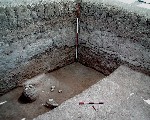 v14 |
| Label is included in another | 2011-8-17 | cJC | ^lam [Input file: V817CJC.J / V817CJC.-J] |
| Category | 1998-7-10 | !! | build-up [Input file: I714JL.J / I714JL.-J] |
| 1998-7-11 | !! | unknown [Input file: I712JLW.J / I712JLW.-J] | |
| Definition | 1998-7-10 | jW | laminations.HTM" TARGET=C3>laminations lamin [Input file: I714JL.J / I714JL.-J] |
| 1998-7-11 | gB | laminations.HTM" TARGET=C3>laminations lamin [Input file: I712JLW.J / I712JLW.-J] |
| Best image | 2011-8-25 | cJC |  v14 |
| Description | 1998-7-12 | gB | at the end of the day, beginning to see more inclusions, namely plaster chunks, charcoal lumps and whitish stones (one group of 4). Generally laminations are still showing up across the entire north half of k1. Relatively clear transition between f5 fill and f8 laminations in baulk. [Input file: I712JLW.J / I712JLW.-J] |
| 1998-7-13 | jW | scraped after first pick run. General conditions noted today by gB still apply. More charcoal flakes and more stones are evident. Stones are concentrated in NE corner and in region to south of pedistaled stones. Laminations present in all parts of N half of square. [Input file: I714JLW.J / I714JLW.-J] | |
| 1998-7-13 | jW | scraped after second pick run. The consistency and texture of the laminations began to change, particularly in the western part. Soil became more powdery and took on a more reddish hue. Also somwhat drier. Laminations still clearly evident. [Input file: I714JLW.J / I714JLW.-J] | |
| 1998-7-13 | jW | the pile of six stones seems to have been placed rather than randomly deposited. [Input file: I714JLW.J / I714JLW.-J] | |
| 1998-7-14 | gB | inspected excavated area after final cleanup. f8 seems to consist of three more or less equal sections. f9 imbedded in f8 in the eastern third. The separation is still distinct, although the dimensions and orientaion are somewhat altered. In the eastern third, there is a dark area, not yet well defined, which resembles f10 in color and inclusions (eg. charcoal). The middle third is bounded by f11 on the north and contains a line of stones extending south to the unexcavated platform of f8 material in the south half of k1. It appears as if this center section may have bisected two areas of similar use, but it would take several more pick runs to test this hypothesis. The north face of the platform did not show these demarcations, nor did it show any evidence of horizontal separations that might have been associated with a floor. A significant amount of pottery, bone and two possible seal impressions were found in the west part, matching previous experiences. [Input file: I714JLW.J / I714JLW.-J] |
| Daily | 1998-7-12 | jW | soil in northeast quadrant beneath f5 continues to show clear evidence of laminations and moisture retention noted by GB on I711. Residue after scraping resembles chocolate shavings. Surface extremely greasy, making it difficult to cut with a trowel. [Input file: I712JLW.J / I712JLW.-J] |
| Strategy | 1998-7-12 | gB | We consider f8 to extend across the entire North sector of k1, and continue digging across this sector, trying to rach a lower definition of these laminations. [Input file: I712JLW.J / I712JLW.-J] |
| 1998-7-13 | gB | we continue digging across northern half of k1, assuming uniformity of deposition ( f8). The goal is to find som definition at the bottom which would provide an excellent stopping point for this operation (especially since as of tomorrow the workmen will be needed elsewhere - B6-B7). [Input file: I714JLW.J / I714JLW.-J] | |
| 1998-7-13 | jW | we will pedistal the stones as we excavate, only in order to retain a point of reference. [Input file: I714JLW.J / I714JLW.-J] | |
| Procedure | 1998-7-11 | gB | I scraped after workmen did a careful cleaning. Soil flakes off very neatly, but shows neither a consistent slope nor strong compaction from above. It is very moist. [Input file: I712JLW.J / I712JLW.-J] |
| 1998-7-12 | gB | I inspected carefully the portion exposed (North half of k1) and concluded tht we have a uniform set of laminations across the part exposed. Material flakes off in fairly uniform, wide scales, which are rather soft and leave a fairly well-marked surface. However, neither does any portion of the surface extend very far, nor is there any indication of compaction. [Input file: I712JLW.J / I712JLW.-J] |
| Locus | 1998-7-10 | jW | k1 [Input file: I714JL.J / I714JL.-J] |
| Elevation | 1998-7-10 | jW | 0 @top [Input file: I714JL.J / I714JL.-J] |
| 2011-9-8 | cJC | 7637 @bottom [Input file: V908CJC.J / V908CJC.-J] | |
| 2011-9-8 | cJC | 7677 @top [Input file: V908CJC.J / V908CJC.-J] | |
| D99.NVolmtrc | 2011-9-8 | cJC | The original elevations were measured from the surface down and appear in the record with these numbers. In 2011 cJC used the absolute elevation of m1869 which was located on the surface near OH2 to convert these measurements. [Input file: V908CJC.J / V908CJC.-J] |
| Slope | 1998-7-14 | gB | the alignment of inclusiions was never clear while digging, except for patches of stones and sometimes the patches of gypsum flecks. But the sections show a clear horizontal alignment both E-W and N-S. There seems to be, however, a rise to the East, which was noted while excavating, and which shows clearly in N8. [Input file: I714JLW.J / I714JLW.-J] |
| Type of contact: Latest events | 1998-7-12 | gB | f5 (subfloor) covers f8 [Input file: I712JLW.J / I712JLW.-J] |
| 1998-7-12 | gB | f9 (accumulation C) overlays f8 [Input file: I712JLW.J / I712JLW.-J] | |
| 1998-7-12 | gB | f6 (hole) intrudes in f8 [Input file: I712JLW.J / I712JLW.-J] | |
| Type of contact: Contemporary events/Movable items | 1998-7-12 | jL | q17 sits in f8 [Input file: I714JL.J / I714JL.-J] |
| 1998-7-13 | jL | q18 sits in f8 [Input file: I714JL.J / I714JL.-J] | |
| 1998-7-13 | jW | q19 sits in f8 [Input file: I714JL.J / I714JL.-J] | |
| 1998-7-13 | jW | q21 sits in f8 [Input file: I714JL.J / I714JL.-J] | |
| Type of contact: Earliest events | 1998-7-15 | jW | f8 covers f10 (laminations lamin) [Input file: I715JLW.J / I715JLW.-J] |
| 1998-7-15 | jW | f8 covers f11 (fill) [Input file: I715JLW.J / I715JLW.-J] | |
| Inclusions | 08-25-2016 | !! | frequencies of ceramic vessels and sherds included within feature |
| H99.NDepostn | 1998-7-11 | gB | I assume this is the the result of water sitting within a bowl-like setting, hence giving evidence, in my estimation, of abandonment. Jim reminds me that laminations suggest containment; in this case this would possibly entail the presence of partially collapsed walls within which the settling of the water would have occurred. [Input file: I712JLW.J / I712JLW.-J] |
| 1998-7-14 | gB | U assume that the rise to the east is part of a general ridge which somehow delimits ane contains f5 (the subfloor). The western edge of this limit ought to be a structure hidden under the toplogical rise shown in v6. If so, the rise to the East of f8 represents some preexisting mass (a decomosed wall? a simple berm?) which retained water and dissolved itself into laminations. [Input file: I714JLW.J / I714JLW.-J] |
| Stratum to which element belongs | 2011-8-27 | cJC | s630OH2 [Input file: V827CJC.J / V827CJC.-J] |
| Phase to which stratum belongs | 2011-8-27 | cJC | h3pOH2 [Input file: V827CJC.J / V827CJC.-J] |
| Color definition | 1998-7-11 | gB | brown [Input file: I712JLW.J / I712JLW.-J] |
| 1998-7-12 | jW | dark brown [Input file: I712JLW.J / I712JLW.-J] | |
| Color number | 1998-7-12 | jW | 7.5YR4/3 [Input file: I712JLW.J / I712JLW.-J] |
| Texture | 1998-7-11 | gB | thick flakes, very plastic, meaning that it congeals easily. [Input file: I712JLW.J / I712JLW.-J] |
| 1998-7-13 | gB | I picked, scraped and brushed the surface exposed in No. half of k1 (right after taking pictures for v5). The Eastern portion is harderand drier (and dryness does not seem to be a correlative of excavation times; in other words, there may be a real difference between E and W. Yet, it is not marked enough, nor is there any observable boundary between the two, to allow us to establish a new feeature(though it would match what was observed at a higher elevation between f9 and f8). In the West, the material is more granular and greasy, while in the East it remains scaly and flaky. [Input file: I714JLW.J / I714JLW.-J] |
| Generic function | 1998-7-13 | gB | the general concentration of finds to the West suggests, perhaps, that we have the tail end of a deposit linked with a structure to the West, which is presumably hidden under the rise visible on the surface (see v6). [Input file: I714JLW.J / I714JLW.-J] |
| 1998-7-14 | gB | stones, laminations support outdoor area, possibly in front(E) of building. But no trash decomposing, since deposit is very clear. [Input file: I714JLW.J / I714JLW.-J] |
| Photo of view | 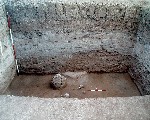 v8 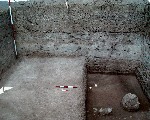 v9 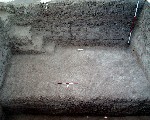 v10 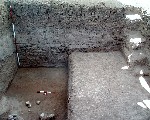 v11 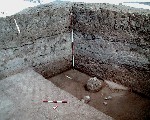 v12 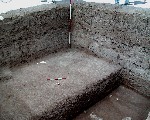 v13  v14 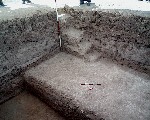 v15 | |||||||
| Drawing of view | w3 |
w4 |
w5 |
w6 |
||||
| Drawing of view | w7 |